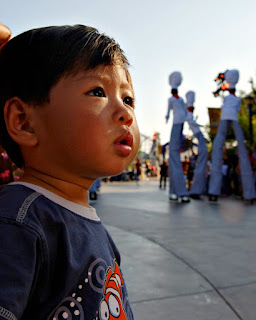From time to time I look at photos I've taken in the past to analyze how I can continue to improve. Here are some comparisons between some photos I've taken before and some that I took recently.
-----------
Comparison 1: Post-processing
Comparison 1: Post-processing
 |
| April 2011 |
 |
| September 2012 |
The shots here were taken in similar ambient conditions (sun above and behind the subjects, subjects facing open light). In the top one I added flash bounced off a reflector. The bottom one was all ambient. These days I use my flash less and rely more on post-processing.
In terms of composition, both were taken with a wide angle lens (around 24mm equivalent) but the top one was taken much closer to the subject for a more casual, intimate feel, while the lower one is more formal and the foliage takes on a more prominent role as a natural frame.
For me the biggest difference is how the two shots were processed. Both have deep blacks and bright highlights but the top one looks more contrasty, while the bottom one has much less contrast in the midtones. The bottom one is also less saturated, and looks more natural to me.
BTW, the top was with a D300 and Tamron 17-50 VC while the bottom was with an LX5. Until we got the LX5, I was bringing the D300 everywhere. Now I make a conscious decision to bring a DSLR or the LX5 depending on the opportunities I'm likely to encounter, and the kinds of shots I want (taking into account the depth of field I would want, and whether I could use the 10-17 fisheye, 11-16 ultrawide, or Sigma 50-150 for telephoto).
RELATED POSTS:
----------
Comparison 2: Backlit shots
 |
| October 2009 |
 |
| August 2012 |
In this pair of shots, the ambient conditions again appear similar by the look of the shadows (cloudless sky, sun at around the same angle). The most significant differences in these two shots are the intent and the camera. In the top one, I did not care about preserving highlights and as you can see the sky was blasted to white. Now, I actively seek to preserve highlights as much as possible, which leads to the second difference -- the camera. The shot on top was taken with a Nikon D80, while the bottom one was taken with a Fuji S5 which has exceptional highlight range. With the Fuji S5 and my active intent to preserve highlights (by choosing an exposure that avoids blownout highlights), I was able to preserve all highlights in this contrasty scene.
RELATED POSTS:
-------------
Comparison 3: Direct Sunlight
 |
| October 2009 |
 |
| August 2012 |
Both of these shots were taken in direct sunlight (although in the top one, the sun is at a lower angle) but the way the sun was used is very different. In the top shot, the sun was acting as key light. In the bottom shot, the sun was acting as an accent light.
RELATED POSTS:
-------------
Comparison 4: Parades
 |
| August 2009 |
 |
| August 2009 |
 |
| December 2009 |
 |
| October 2011 |
 |
| August 2012 |
The three shots on top are representative of the kinds of photos I used to take when we watch parades. At that time, I had been using the Tamron 28-75 on a Nikon D80, giving an equivalent focal length of 42mm at its widest, which is to say not wide at all. I've since switched to the Tamron 17-50 VC and positioned myself further away from my kids so I can capture more of the event. Recently I also acquired the Tokina 11-16 ultrawide and Tokina 10-17 fisheye which allow me to capture more of the scene and enable me to get shots of the parade even when my position is not ideal.
RELATED POSTS:
-------------
Comparison 5: Night Portraits
 |
| September 2008 |
 |
| October 2011 |
These were all shot in Disneyland, on Main Street. In the top shot, I was able to get a sharp shot in low light by using flash, while also preserving some of the ambience by allowing a sufficient amount of ambient light from the background. The problem (besides the dude on the right) is that the flash looks very unnatural. Now, I use two solutions for this kind of situation.
The first alternative is to use bounce flash. Yes it can be done, even outdoors. In the middle shot, I just bounced the flash off the shop windows. To make this work, you need three tools: First, a fast (i.e. wide aperture) lens -- f/2.8 or wider. Here I used the Tamron 17-50 VC. Second, you also need a camera with decent noise at ISO 1600 or preferably ISO 3200 or above (here I was using the D300 at 1600 ISO, which is so-so). Third, you need a powerful flash. I was using the SB-800, zoomed to 105mm. It was on TTL so I don't know how much power it used but I am almost sure it was close to full power.
The second alternative is to use a handheld umbrella. In the bottom shot, I was using the Lumix LX5 with the Lastolite Brolly Grip.
RELATED POSTS:












0 comments:
Post a Comment